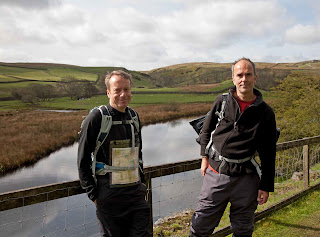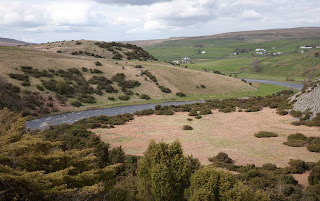From the ridiculous to the sublime, day 12 (Friday 26th April) had some of the best weather and best walking so far,
almost cancelling out yesterday's horrors. The route today consisted of crossing north from Baldersdale past some of the Tees reservoirs, cutting across farmland to Middleton-in-Teesdale, then following alongside the river Tees up to tonight's stop.
Almost as soon as we had left last night's B&B in Baldersdale, on crossing the head of the Blackton Reservoir we met two local women out walking what looked to me like a small black whippet, so I had to stop and talk to them. It turned out to be a black whippet-bedlington cross, only 8 months old, but for a few minutes an acceptable substitute for one of my whippets back home. The whippet rejoiced in the unlikely name of Busty, but apparently Busty is the name of an
old Durham colliery.
 |
| Busty the almost whippet |
Since they insisted on taking our photograph in return, here's a rare one of Jonathan (relaxed and smiling) and me (twisted and grimacing) at the western end of Blackton Reservoir.
 |
| Jonathan and me at Blackton Reservoir |
Heading north from Blackton Reservoir the footpath passes by
Hannah's Meadow at Low Birk Hatt Farm. This is where sheep farmer Hannah Hauxwell lived for 50 years, becoming the subject of several television series and documentaries telling of her life as a solitary sheep farmer in a house without mains water or electricity. The farm and its fields are now a Site of Special Scientific Interest and a visitor's centre.
Heading north from here the path crosses Hunderthwaite Moor and Mickleton Moor, which today were similar to yesterday's boggy moorland, requiring hopping between tussocks of grass to cross, but only a mile or so further on we reached the head of Grassholme Reservoir and there moorland suddenly stops and grassy sheep and cattle farms take over.
 |
| Grassholme Reservoir |
As with the reservoirs we had passed last week these reservoirs (Blackton, Hury, and Grassholme) were constructed in the late 1800s to supply water to the rapidly growing nearby cities, in this case to Middlesbrough and Teesside, where the steel and coal industries were leading to a rapid growth in population. A newspaper clipping in last night's B&B documented the lives of workers housed in temporary sheds during the reservoirs' construction, with each shed housing up to 20 men, and a single woman, usually a widow, acting as the head of household.
Here's a good example of the local farm building style, with this barn having only tiny slits for windows to guard against the harsh winter conditions that are frequent hereabouts.
 |
| Barn just north of Grassholme Farm |
Now heading north-east from farm to farm the path crosses to Middleton-in-Teesdale, a well-heeled small market town, made more attractive by sunshine, making the possibility of eating lunchtime fish&chips outdoors a reality. The last chance of a cash machine for many days, I suspect, but sadly the only outdoor shop where I might have bought a more waterproof jacket was "closed due to illness".
 |
| Approach to Middleton |
From Middleton-in-Teesdale the Pennine Way becomes a riverside trail following up beside the river Tees, more like an afternoon stroll than the strenuous hillwalking of a few days ago. Today's gory picture was taken in one of the fields along the Tees, showing a docked lamb's tail with the rubber band which farmers place around the tail to cut off the blood supply, and thereby the tail. Tails are docked to reduce the likelihood of fly infestations, since sheep's tails aren't the cleanest of places. It doesn't seem to be a universally performed procedure though, and I'd say that at least half of the adult sheep which we're seeing still have their cacky tails intact.
And no, I didn't keep it as a souvenir.
 |
| Docked lamb's tail. |
This section of the Tees is well known for the Low Force and High Force waterfalls, which of course were today in spectacular form after the past few days rain. First we passed Low Force, where the Tees drops about 6 metres over a pair of waterfalls.
 |
| Low Force |
About three miles further upstream is the more famous High Force, about four times the height of Low Force, although through a much narrower channel.
 |
| High Force |
I didn't realise that this section of the Tees is famous for its juniper trees. In fact it's the largest population of juniper trees anywhere in Britain. They're everywhere, along the sides of the Pennine Way, overhanging the cliffs onto High Force, and extending for miles upstream of this. In this photograph a couple of miles upstream of High Force all of the visible trees are juniper, making it look rather exotic, like tea trees in New Zealand.
 |
| Juniper bushes at Bracken Rigg |
Although the juniper berries are currently very immature and green they still smell very strongly if you crush them in your fingers, leaving a lingering smell of gin.
 |
| Immature juniper berries - upper Tees |
The upper Tees is also home to numerous alpine plants which thrive in the damp, cool climate. We'd been told to look out for Spring Gentians, and sure enough here they were on the banks of the Tees where two tributaries merge near Forest-in-Teesdale.
 |
| Spring Gentians on the bank of the Tees |
Today's mileage: 16.8.
Tonight's stop is at the Langdon Beck Hotel, which is over a mile from the Pennine Way, so quite a distance to retrace tomorrow morning. Having chatted to various people in the bar tonight we found that:
- The hotel owner is from Truro (although hasn't been there for over 10 years).
- One of the customers is from a village just outside of Whitley Bay.
- The hotel owner is a huge Stanley Kubrick fan, and I think he and Jonathan are still in deep discussion downstairs about various obsessive details of his films and biographies.
Sean's update: He's camping in Duffton tonight (our stop tomorrow) after a 21 mile day, but given today's good weather I think it's been a shot in the arm for him and Saffie. It looks like the jacket is becoming more Saffie's than his.
 |
| Saffie camping at Duffton |
 |
| On the bank of the Tees I sat down and woofed |
If you would like to donate to the MND Association, please visit
http://www.justgiving.com/PhilipJAWhite













No comments:
Post a Comment